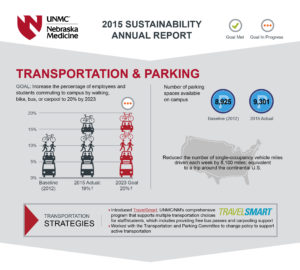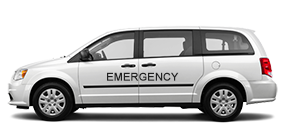Transportation and Parking
Parking cost, availability, and demand reduction programs can influence the transportation choices of staff, students, and visitors when traveling to campus. With approximately 15,000 individuals traveling to campus daily19, UNMC/NM’s campus has a significant impact on the traffic in midtown Omaha. Adopting policies that encourage use of active or lower-emission transportation options can reduce road congestion, reduce pollution, promote healthy lifestyles, and preserve infrastructure.
Baselines
UNMC/NM employees and students
completed a transportation survey in
March 2012. The survey provided the
baseline data for this Plan.
Primary Metric:
• Mode Split: the percent of employees
and students commuting to campus
by a means other than driving alone
in a vehicle.
• Baseline: 12.7 percent
Secondary Metric:
• Total Parking Spaces: the number of
parking spaces available on campus.
• Baseline: 8,925 (calendar year 2012)
A parking space ratio (number of fulltime
equivalent employees and students
per parking space) was also considered
as a secondary metric. However, due to
lack of available data regarding full-time
equivalent employees who are primarily
located on UNMC/NM’s 42nd & Dewey
campus, this metric was not included.
As this data becomes available in the
future, UNMC/NM should consider
tracking this intensity metric, which will
provide another approach for comparing
UNMC/NM to other health care and
university facilities. |
Goal
Commuter Mode Split
By the end of 2023, increase to 20 percent
the percentage of commuting trips
that occur by modes other than driving
alone in a conventionally-fueled vehicle |





